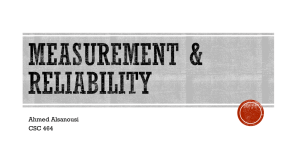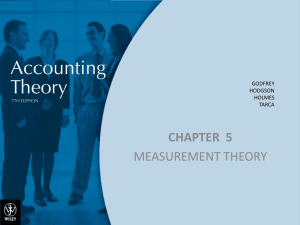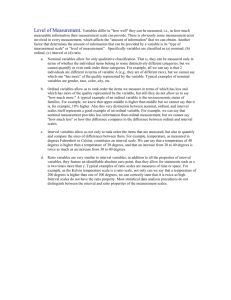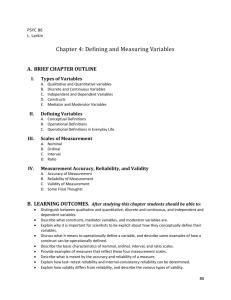497-Measurement
advertisement
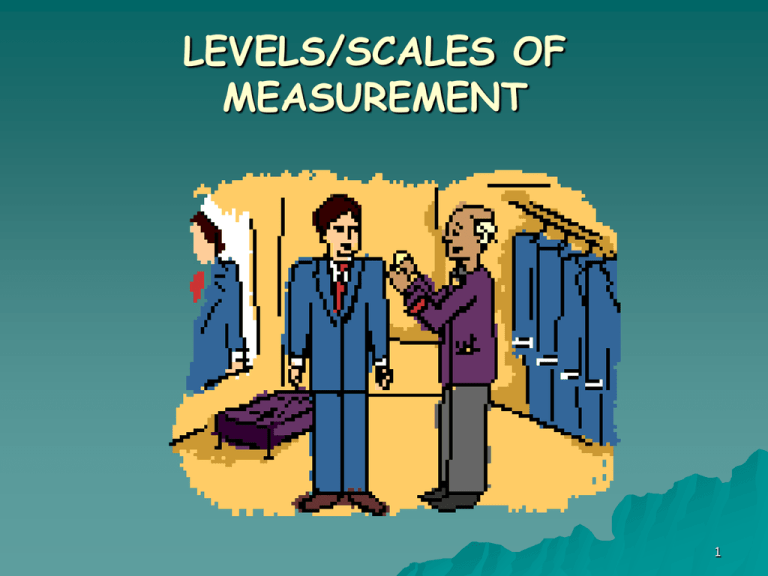
LEVELS/SCALES OF MEASUREMENT 1 Intriguing Observation/Experience, Intellectual Curiosity More Careful Studying of the Phenomenon Defining Research Problem & Objectives THE PROCESS OF Building the Theoretical Framework and the Research Model Refinement of theory EMPIRICAL RESEARCH Testing Hypo.: Data Analysis & Interpretation Developing Research Hypotheses Data Coding, And Editing Operational Definition & Measurement of Research Variables Data Collection Sampling Design LEVELS/SCALES OF MEASUREMENT MEASUREMENT: One of the pillars of science – Only when we begin to assign numbers to describe an object do we begin to learn about that object. “I often say that when you can measure what you are speaking about and express it in numbers you know something about it. But, when you cannot measure it, when you cannot express it in numbers, your knowledge is of a meager and unsatisfactory kind; it may be the beginning of knowledge, but you have scarcely, in your thoughts, advanced to the stage of science, whatever the matter may be.” Lord Kelvin (19th century physicist)3 LEVELS/SCALES OF MEASUREMENT Definition? – Careful and deliberate observation of a phenomenon for the purpose of describing study subjects (e.g., people, objects, organizations, events) in terms of their attributes and properties. – Assigning numbers to attributes/characteristics of study subjects (e.g., people, objects, events, etc.) according to a set of rules. – Measurement represents: “Rules for assigning symbols to objects so as to 1. represent quantities of attributes numerically (i.e., scaling) or 2. define whether the objects fall in the same or different categories with respect to a given attribute (i.e., classification)” (Nunnally & Bernstein, 1994) 4 LEVELS OF MEASUREMENT A fundamental consideration in measurement that influences our choice of alternative measurement procedures is: Levels/Scales of Measurement Levels/Scales of Measurement reflect the precision and amount of information contained in the data. 5 LEVELS OF MEASUREMENT QUESTION: What are some of the ways you would measure/characterize/describe and, thus, compare people’s heights? Weather? Height? Weather? 1. X feet and Y inches 1. X Degrees Fahrenheit 2. Very Tall, Tall, Neither tall or short, Short, Very short 2. Unseasonably hot, Hot, Mild, Cold, Unseasonably cold 3. Taller than average, Average, Shorter than average 3. Hotter than last year, Same as last year, Colder than last year 4. Tall vs Short 4. Hot vs. Cold These represent different levels of precision/crudeness—Levels of Measurement 6 LEVEL/SCALES OF MEASUREMENT What is the Significance of Level of Measurement? The choice of level of measurement (i.e., precision/crudeness of measurement procedure) greatly determines what can/cannot be done with the resulting data when attempting to analyze them—i.e., determines what statistical methods can/cannot be utilized. Let’s examine various levels of measurement! 7 LEVEL OF MEASUREMENT Statistical Techniques and Levels of Measurement: INDEPENDENT Var. NOMINAL/CATEGORICAL N O M I N A L M E T R I C METRIC (ORDERED METRIC or HIGHER) * Chi-Square * Fisher’s Exact Prob. * Discriminant Analysis * Logit Regression * T-Test * Analysis of Variance * Correlation Analysis * Regression Analysis We will come back to this later! 8 LEVELS/SCALES OF MEASUREMENT NOMINAL (CATEGORICAL/DISCRETE): – Lowest level/crudest form – Measure HOW MANY – Typically for classification of people, objects, ideas, events, etc. into discrete categories – Typically involves a choice from a set of mutually exclusive categories (e.g., male vs. female) – Ideally, the list of categories is exhaustive Nominal data represent labels or names (categories) used to identify an attribute of the research subjects. IMPORTANT FEATURES: – Numbers used to designate categories are of no quantitative or relative value--only labels (e.g., social security number) 9 LEVELS OF MEASUREMENT— NOMINAL (Cont.) Permissible operations? – Counting--the only arithmetic operation permitted, and – Comparison of group frequencies/percentages-the only empirical operation applicable Applicable descriptive statistics (Numbers that help describe characteristics of a group/data set in summary form)? –Central tendency--mode –Spread/variability--none Inferential statistics: Nonparametric test 10 LEVELS OF MEASUREMENT ORDINAL: These scales typically involve forced ranking of a set of available options. Subjects are asked to rank (rank order) entities/ objects in terms of the degree to which they possess the characteristic being measured (e.g., brand preference), while NOT allowing assignments of equal ranks to multiple items. Ordinal data have the properties of nominal data, but the order or rank of the data is meaningful. – Relative magnitudes/quantitative values of numbers become relevant--numbers not just labels anymore – They indicate some subjects are lower or higher than others on the characteristic being measured, but not by how much (e.g., preference). IMPORTANT FEATURE: – Intervals between consecutive ranks do not represent equal amounts of the attribute being measured (e.g., first, second, or third most preferred brand) – They are more precise than nominal scales, but not yet very precise, still crude 11 LEVELS OF MEASUREMENT ORDINAL (Con.): • Additional empirical operations are applicable: – Determination of greater or lesser, higher or lower, larger or smaller, darker or lighter, etc. – Transitivity postulate acceptable--i.e., comparison of ranks/positions is allowed (e.g., if a>b and b>c, then a>c) • Descriptive statistics? – Central tendency--mode and median Mode: For most subjects brand X was the 2nd choice Median: For 50% (or more) of the subjects, Brand X was among the top 3 choices – spread/variability--range (minimum and maximum) Inferential statistics: – nonparametric tests 12 LEVELS OF MEASUREMENT INTERVAL: – Provides quantitative/metric measures (is always numeric) – Measures HOW MUCH Important Features: – Very precise measures – Numbers along the scale express a fixed unit of measurement (are of equal size) Interval data: intervals between consecutive points on the scale represent equal amounts of the attribute being measures, but 0 is arbitrary Thus, score intervals can be compared (e.g., temperature) 80 degrees – 60 degrees = 20 90 degrees – 70 degrees = 20 20 = 20 (both represent equal levels of heat differential) Can you say the same for differences in test scores? – But, the zero on the scale is arbitrary (e.g., altitude); The scale does NOT have an absolute/true zero. 13 LEVELS OF MEASUREMENT INTERVAL (Con.) – So, ratios of scores will be misleading E.g., comparisons such as “Object A is 3-times hotter than object B,” is typically wrong. NOTE: There are very few technically true/pure interval scales (i.e., exact but with an arbitrary zero, notable among them Fahrenheit and Celsius temperature scales). Descriptive statistics? – Central tendency--mean, mode, median – Spread/variability--standard deviation or variance, range, minimum and maximum • Inferential statistics? –parametric tests –nonparametric tests 14 LEVELS OF MEASUREMENT RATIO: – Highest/most precise level of measurement Important Features: – Precise/exact like interval scales, but with a true/absolute/meaningful zero indicating nothing exists. – Meaningful ratios of scores can be derived (e.g., distance, height, weight, income, etc.) “A is twice as long as B” would be a correct comparison (e.g., income, age) Descriptive statistics? –Central tendency--mean, median, mode –Spread/variability--standard deviation or variance, range, minimum and maximum • Inferential statistics? –parametric tests –nonparametric tests 15 LEVELS OF MEASUREMENT ORDERED METRIC: – Technically/strictly speaking NOT really interval (not as precise), but are superior to purely ordinal (forced ranking) scales. EXAMPLES? IQ scores, score on an exam, and many rating scales used in survey research (e.g., Likert scales, comparative scales, etc.) When response options follow an ordered sequence; larger number represent more /less of what is being measured. – In practice, can be treated as if they were interval (They provide continuous/metric measures/ratings) – Permit virtually all same operations and analyses that are applicable to interval scales – NOTE: Measures that are ordered metric or higher (i.e., ordered metric, interval, or ratio) we will refer to as “METRIC or QUANTITATIVE” 16 LEVELS OF MEASUREMENT IMPORTANT NOTE: Level of measurement is a function of how you choose to measure a variables, and often NOT an inherent characteristic of the concept being measured. EXAMPLE: Height--Operationalization Level of Measurement • Number of feet/inches ? Ratio • 1=Very Short, 2=Short, 3=Average, 4=Tall, 5=Very Tall ? Ordered Metric • 1=Short, 2=Tall ? Nominal • 1=Freshman, 2=Sophomore, 3=Junior, 4=Senior, 5=Graduate ? Ordered Metric 17 LEVELS OF MEASUREMENT NOTE: • Appropriate statistical analysis for nominal and ordinal measures are rather limited. • Higher-level measures can be converted to lower-levels and, thus, treated as such. But the opposite cannot be done. CONCLUSION: – When you have a choice, measure your variables at the higher levels of measurement, unless there is a compelling/practical reason for not doing so. 18 LEVEL OF MEASUREMENT Remember: Level of measurement determines choice of statistical method. Statistical Techniques and Levels of Measurement: INDEPENDENT Var. NOMINAL/CATEGORICAL N O M I N A L M E T R I C METRIC (ORDERED METRIC or HIGHER) * Chi-Square * Fisher’s Exact Prob. * Discriminant Analysis * Logit Regression * T-Test * Analysis of Variance * Correlation Analysis * Regression Analysis 19 LEVELS OF MEASUREMENT QUESTIONS OR COMMENTS 20


